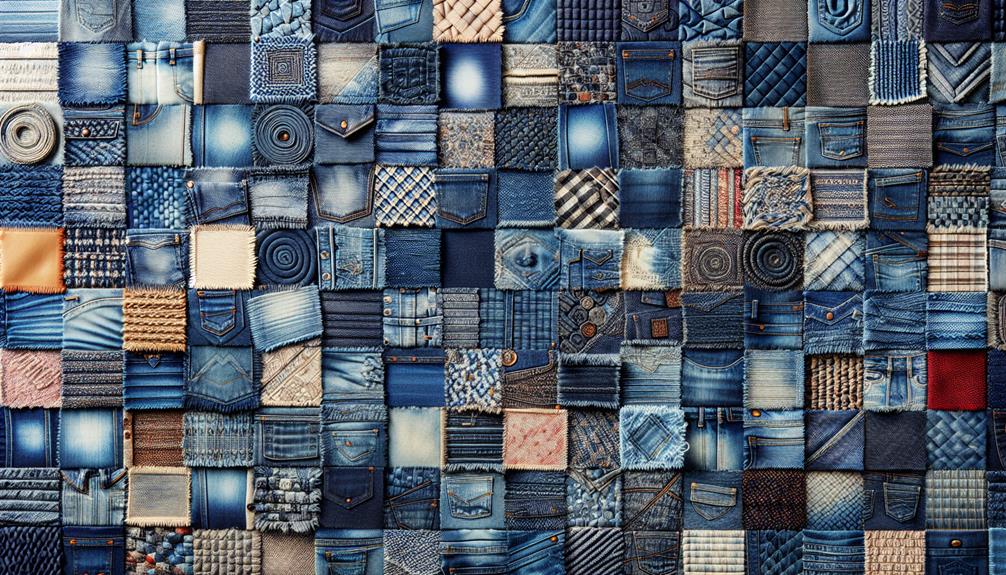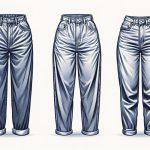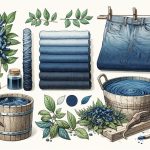When I think about denim, the first thing that pops into my head is its classic blue jeans look. But there's so much more to it than just the iconic color or even the material itself. It's fascinating how something originally made for miners has turned into a global fashion powerhouse. From different weights to a variety of colors, denim's versatility is unmatched. Yet, I often find myself wondering, with all these variations, what truly defines denim? Let's peel back the layers of this ubiquitous fabric and explore its core. You might be surprised by what we uncover.
Table of Contents
Key Takeaways
- Denim is a cotton twill fabric known for its use in making blue jeans.
- It features a unique construction with warp threads dyed in indigo, gray, or white.
- Considered durable, denim is made from 100% cotton, enhancing its longevity and ability to mold to the wearer's body over time.
- The fabric is identifiable by its distinctive twill weave, setting it apart from other materials.
- Denim evolves with wear, getting softer and more comfortable, and requires minimal care to maintain its appearance.
Defining Denim's Identity
At its core, denim is a hardy, cotton twill fabric that's become a staple in our closets. It's the go-to material for blue jeans, a universal piece of clothing loved by many. The magic of denim fabric lies in its unique construction, woven with indigo, gray, or mottled white yarn. This not only gives denim its distinctive look but also contributes to its rugged durability.
What sets denim apart, especially when we talk about authentic denim, is its 100% cotton composition. This is key for both its durability and its ability to mold to the wearer's body over time. It's fascinating how a pair of blue jeans can become more comfortable and fitting with age, almost like they're a part of you.
Another aspect of denim that I appreciate is its low maintenance. It doesn't wrinkle easily and is pretty straightforward to care for. This, combined with the indigo dye that gives denim its classic color, makes it an enduring favorite in fashion. It's clear that denim's identity is deeply rooted in its practicality, versatility, and timeless appeal.
Types of Denim Fabric
Now, let's talk about the different types of denim fabric out there.
We'll explore the contrast between raw and washed denim, and why that matters for your jeans' look and feel.
Plus, I'll break down denim weights, so you can figure out what's best for your style and comfort.
Raw Vs. Washed Denim
When it comes to denim, you're basically choosing between raw or washed, each with its own vibe and comfort level. Raw denim, made from cotton and crafted with a twill weave, stays untouched after dyeing, which means it's stiff but uniquely yours over time. Washed denim, however, has been through a cycle to soften it up and prevent any surprises in size after your first wash.
Here's what you need to know:
- Raw Denim develops a personalized fade, requiring patience but rewarding with character.
- Washed Denim offers immediate comfort and a consistent look without the wait.
- The choice ultimately reflects your lifestyle: Do you value the journey of breaking in raw denim, or do you prioritize comfort and convenience with washed denim?
Denim Weights Explained
Having explored the difference between raw and washed denim, let's talk about another key aspect: denim weights, which range from lightweight to heavyweight, shaping both the feel and functionality of your jeans.
You see, cotton denim comes in various weights, each offering a unique experience. Lightweight denim, up to 8oz, is your go-to for comfort and breathability, perfect for warmer days.
Then there's midweight denim, sitting between 8oz and 10oz, striking a balance between durability and comfort. It's versatile, suitable for most seasons.
For those seeking durability above all, heavyweight denim, ranging from 11oz to 20oz, offers a robust quality unmatched by lighter fabrics.
These differences allow for customization in comfort and durability, catering to individual preferences and needs in denim.
Denim Weights Explained
Let's dive into the world of denim weights, which range from lightweight to heavyweight, affecting everything from durability to comfort. The fabric's weight is crucial because it directly impacts the garment's comfort level and durability. Whether you're picking out a new pair of jeans or designing a denim jacket, understanding these weights can help you make an informed decision.
Here's a quick rundown:
- Lightweight Denim (up to 8oz): This type is soft, breathable, and great for those warmer days. It's less durable than its heavier counterparts but offers unparalleled comfort.
- Midweight Denim (8oz to 10oz): The middle ground in denim, providing a balance between comfort and durability. It's versatile enough for everyday wear while still being robust.
- Heavyweight Denim (11oz to 20oz): For those who value durability over everything. It's stiffer and takes a while to break in, but it's incredibly long-lasting.
Understanding these weights is key to choosing the right denim fabric for your style and comfort level. Whether you prefer the airy feel of lightweight denim or the ruggedness of heavyweight, there's a perfect denim weight for everyone.
Colors of Denim
When we think about denim, the classic blue hue is usually what springs to mind first. But there's a whole spectrum out there, from black and white to vibrant reds and soft pinks.
Let's explore these colors, including the trendy acid wash and the subtle shades of chambray, to see how they've expanded the denim universe.
Traditional Blue Hues
The iconic blue color of denim comes from indigo dye, a choice that's stood the test of time for its rich, lasting shades. This dye has been the backbone of denim materials, lending itself to a spectrum of blue shades that define the very essence of what we consider denim today. Through varying the indigo dyeing techniques and concentrations, we get to enjoy a range of different shades, from deep, dark indigo to lighter, more playful blues.
Here's why these blue hues matter:
- Indigo dye ensures denim's timeless appeal and durability.
- Blue shades provide a versatile palette for styling.
- Different shades allow for personal expression through denim materials, catering to everyone's taste from classic to modern looks.
Beyond Blue Varieties
Exploring beyond traditional blues, denim also rocks in a rainbow of colors like red, white, green, and pink. It's not just about shades; it's about expressing yourself with colored denim fabric that offers endless possibilities for crafting unique looks.
For those who dig a more edgy vibe, acid wash denim is a go-to. It's all about the bleaching techniques that give it that distinct, lived-in look everyone's after.
Then there's black denim, which is a whole mood by itself. Dyed with sulphur dyes, it offers a sleek, versatile choice that goes with practically anything.
The variety of colors available in denim fabric today is largely thanks to different dyeing processes, including those same sulphur dyes. It's clear, denim's not just blue; it's every color of the rainbow, each with its own story.
Trending Denim Colors
As we dive into current fashion trends, it's clear that denim's palette has evolved far beyond its classic blue origins. Today, the spectrum of denim colors is more vibrant and diverse, catering to every fashionista's taste. Here's a quick rundown of the hues making waves:
- Classic Blue: The timeless choice that ranges from light to dark washes, proving blue never goes out of style.
- Black and White Denim: These monochromatic options add a sleek, modern twist to any wardrobe, with black offering edgy variations thanks to different dyeing processes.
- Acid Wash: Known for its distinctive faded look, acid wash denim brings a retro vibe that's fiercely back in trend.
Each color and finish opens up new possibilities for expressing personal style, ensuring there's a denim shade for everyone.
Denim Care Instructions
Let's dive into how you can keep your denim looking and feeling its best with some simple care instructions. One key tip I've learned is to always wash denim inside out. This trick is a game-changer for preventing fading and preserving that rich color we all love in our jeans.
And speaking of washing, you don't need to overdo it. Washing your jeans only once every five wears is plenty to maintain their quality without causing unnecessary wear.
Another thing I've picked up is to tumble dry denim on low heat. It helps retain the shape and fit that we work so hard to break in just right. But, what really makes denim special to me is how wearing it regularly allows it to mold to my body, creating that personalized fit that feels like it's made just for me.
Plus, denim gets softer and more comfortable with age, which means it actually requires minimal care to keep it looking great.
The Evolution of Denim
Denim's journey from practical workwear to a worldwide fashion staple is a fascinating tale of transformation. Initially designed for miners and cowboys, its durability made it the ideal choice for those who needed tough clothing for tough jobs.
The evolution of denim can be broken down into a few key milestones:
- The Origins: Denim traces its roots back to France, where the unique weaving of warp yarn and weft yarn created the durable fabric we know today. This technique ensured that denim could withstand the wear and tear of manual labor.
- Levi Strauss & the 1870s: Levi Strauss popularized denim jeans in the 1870s, introducing them to a broader audience. By using rivets to reinforce the pants' stress points, he created a product that wasn't only durable but also stylish in its dark blue color.
- The 1950s Rebellion: Jeans became a symbol of rebellion in the 1950s. Young people donned denim as a way to push back against societal norms, cementing its place in fashion history as a symbol of youth and freedom.
Denim's evolution from a utilitarian fabric to a fashion icon shows its versatility and enduring appeal.
Frequently Asked Questions
What Counts as Denim?
I'd say denim's basically a tough cotton fabric, often blue, made for durability. It's not just jeans; it includes jackets and skirts too. Stretch versions exist for more comfort without losing that classic denim vibe.
Is Black Jeans Considered Denim?
Yes, black jeans are considered denim because they're made from the same durable cotton twill fabric, just dyed black. They offer a stylish twist while keeping the classic denim qualities we all love.
What Is an Example of Denim?
I'd say blue jeans are a classic example of denim. They're not just popular; they're iconic in fashion. Denim's versatility also shines in jackets, overalls, dresses, and skirts, showcasing its wide-ranging appeal.
What Is Difference Between Denim and Non Denim?
I'm looking at how denim differs from non-denim. Denim's a tough cotton twill, mainly for jeans and jackets, while non-denim includes various fabrics like polyester or rayon, used in a wider range of clothing.
- Tetron Fabric Vs Other Fabrics: a Comparative Analysis - June 17, 2025
- Creative Uses for Tetron Fabric in Fashion and Home Decor - June 17, 2025
- Tetron Fabric HS Code: Import and Export Information - June 17, 2025







